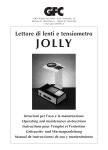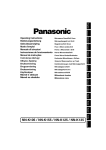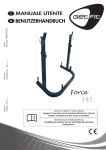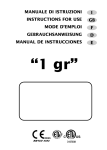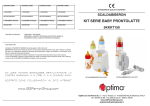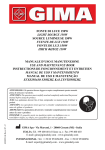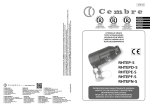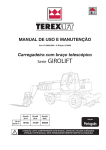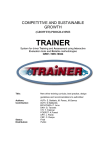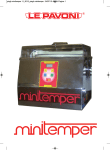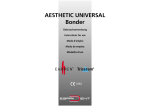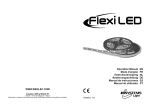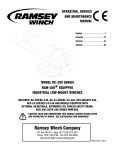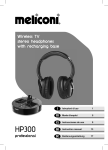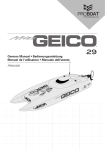Download twist - Centro Style
Transcript
20021 Bollate (MI) ITALY - Viale Lombardia, 18 Telefono 02 38302386 r.a. - Telefax 02 38302389 TWIST Istruzioni per l’uso e la manutenzione Operating and maintenance instructions Instructions pour l’emploi et l’entretien Gebrauchs- und Wartungsanleitung Manual de instrucciones de uso y mantenimiento Rev. 0/99 Pag. 1 di 10 di gianfranco conti - 20021 Bollate (MI) ITALY - Viale Lombardia, 18 - Telefono 02 38302386 r.a. - Telefax 02 38302389 DICHIARAZIONE CE DI CONFORMITÀ CE COMPLIANCE DECLARATION / DECLARATION DE CONFORMITE CE CE - ÜBEREINSTIMMUNGSERKLÄRUNG / DECLARACION CE DE CONFORMIDAD LA SOTTOSCRITTA / The undersigned / La soussignée / Die unterzeichnende Firma / Quien suscribe GFC Viale Lombardia, 18 I - 20021 Bollate (Milano) DICHIARA SOTTO LA PROPRIA RESPONSABILITÀ CHE L’APPARECCHIO: on his own responsibility, declares that the equipment déclare sous sa propre responsabilité que l’appareil erklärt unter eigener Verantwortung, daß das Gerät declara bajo su responsabilidad que la maquina Tipo / Type / Type / Vom Typ / Tipo MACCHINA PER COLORAZIONE LENTI ORGANICHE ORGANIC LENS COLOURING MACHINE APPAREIL A COLORER LES VERRES ORGANIQUES GERÄT ZUM EINFARBEN ORGANISCHER GLÄSER MÁQUINA PARA LA COLORACION DE LENTES ORGANICOS Modello / Model /Modèle /Modell / Modelo TWIST Anno di costruzione / Year of construction Année de construction / Baujahr / Año de fabricación .................. DESCRITTA IN APPRESSO DESCRIBED HEREAFTER / DECRIT CI-APRES / NACHSTEHEND ALS / DESCRIPTA A CONTINUACION Macchina a bagno d’olio per la colorazione delle lenti organiche. Oil bath machine for colouring of organic lenses. Machine à bain d’huile pour la coloration des verres organiques. Maschine mit Ölbad zum Färben von organischen Linsen. Máquina en baño de aceite para la coloración de las lentes orgánicas. È CONFORME ALLE DISPOSIZIONI LEGISLATIVE CHE TRASPONGONO LA DIRETTIVA MACCHINE 98/37/CE, LA DIRETTIVA BASSA TENSIONE 73/23/CEE E SUCCESSIVI EMENDAMENTI, E LA DIRETTIVA COMPATIBILITÀ ELETTROMAGNETICA 89/336/CEE. COMPLIES WITH PROVISIONS CONTAINED IN DIRECTIVES REGARDING MACHINES (98/37/CE), LOW VOLTAGE (73/23/CEE) WITH SUBSEQUENT AMENDMENTS AND ELECTROMAGNETIC COMPATIBILITY (89/336/CEE). EST CONFORME AUX DISPOSITIONS LÉGISLATIVES QUI TRANSPOSENT LA DIRECTIVE MACHINES 98/37/CE, LA DIRECTIVE BASSE TENSION 73/23/CEE ET AMENDEMENTS SUCCESSIFS ET LA DIRECTIVE COMPATIBILITÉ ELECTROMAGNÉTIQUE 89/336/CEE. ENTSPRECHEND DEN GESETZLICHEN BESTIMMUNGEN, DIE DIE MASCHINENRICHTLINIEN EG-98/37, DIE NIEDRIGSPANNUNG-RICHTLINIE EG 73/23 SOWIE DIE DARAUFFOLGENDEN BESTIMMUNGEN SOWIE DIE RICHTLINIEN ZUR ELEKTROMAGNETISCHEN KOMPAKTIBILITÄT EG 89/336 WIEDERGEBEN. ES REALIZADA DE CONFORMIDAD CON LAS DISPOSICIONES LEGISLATIVAS QUE TRANSPONEN LA DIRECTIVA SOBRE MÁQUINAS 98/37/CE, LA DIRECTIVA SOBRE BAJA TENSIÓN 73/23 CEE Y SUCESIVAS ENMIENDAS Y LA DIRECTIVA SOBRE COMPATIBILIDAD ELECTROMAGNÉTICA 89/336/CEE. Conti Gianfranco NOME / NAME / NOM / NAME / NOMBRE POSIZIONE . . . STATUS . . . . . . STATUT . . . . . . GESETZLICHER POSICION . . . . . . . . . . . . . . . . . . . . . . . . . . . . . . . . . . . . . . . . . . . . . . . . . . . . . . . . . . . . . . . . . . . . . . . . . . . . . . . . . . . . . . . . . . . . . . . . . . . . . . . . . . . . . . . . . . . . . . . . . . . . . . . . . . . . . . . . . . . . . . . . . . . . . . . . . . . . . . Titolare Owner Titulaire Vertreter Titular luogo e data / place and date lieu et date / Ort und Datum / lugar y fecha firma / signature signature / Unterschrift / firma Bollate, lì ............................................................................................... ........................................................................................... Rev. 0/99 Pag. 2 di 10 di gianfranco conti - 20021 Bollate (MI) ITALY - Viale Lombardia, 18 - Telefono 02 38302386 r.a. - Telefax 02 38302389 TWIST Costruttore / Manufacturer / Constructeur / Hersteller / Fabricante Viale Lombardia, 18 20021 Bollate (Milano) ITALIA MACCHINA PER COLORAZIONE LENTI ORGANICHE / ORGANIC LENS COLOURING MACHINE APPAREIL A COLORER LES VERRES ORGANIQUES / GERÄT ZUM EINFARBEN ORGANISCHER GLÄSER MÁQUINA PARA LA COLORACION DES LENTES ORGANICOS Tipo / Type / Type / Vom Typ / Tipo Modello / Model / Modèle / Modell / Modelo Matricola / Serial Number / Matricule Geräte Nummer / Matrícula Anno di costruzione / Year of construction Année de construction / Baujahr / Año de fabricación Alimentazione / Power supply / Alimentation / Betriebs-spannung / Alimentación Fusibile / Fuse / Fusible / Schmelzsicherung / Fusible Watt Kgs. Hz TWIST ............... M 1999 M 2000 M 2001 230 Volt 10 Amp. 1600 50 Istruzioni per l’uso e la manutenzione Operating and maintenance instructions Instructions pour l’emploi et l’entretien Gebrauchs- und Wartungsanweisungen Instrucciones de empleo y manutención ITALIANO Rev. 0/99 Pag. 3 di 10 di gianfranco conti - 20021 Bollate (MI) ITALY - Viale Lombardia, 18 - Telefono 02 38302386 r.a. - Telefax 02 38302389 INDICE 1 NORME ED AVVERTENZE GENERALI ......................................................................................................... 5 1.1 PREMESSA ........................................................................................................................................................... 5 1.2 DESCRIZIONE DELLA MACCHINA ................................................................................................................ 5 1.3 RIFERIMENTI NORMATIVI .................................................................................................................................... 5 1.3.1 Normativa obbligatoria ............................................................................................................................................ 5 1.3.2 Normativa volontaria ................................................................................................................................................. 5 1.4 PREDISPOSIZIONI A CARICO DEL CLIENTE ......................................................................................... 5 1.5 RICHIESTA INTERVENTI E RICAMBI ................................................................................................... 5 2 CARATTERISTICHE TECNICHE .............................................................................................................. 6 3 INSTALLAZIONE ............................................................................................................................................. 6 3.1 PIAZZAMENTO ................................................................................................................................................ 6 3.2 ALLACCIAMENTO E MESSA IN SERVIZIO ...................................................................................... 6 4 FUNZIONAMENTO E USO ...................................................................................................................... 7 4.1 FUNZIONAMENTO ....................................................................................................................................... 7 4.2 OPERATORE ....................................................................................................................................................... 7 4.3 USO PREVISTO ................................................................................................................................................ 7 4.4 AVVERTENZE DI SICUREZZA .................................................................................................................. 7 5 ISTRUZIONI PER L’OPERATORE .......................................................................................................... 8 5.1 COMANDI E UNITÀ DI GOVERNO ................................................................................................... 8 5.2 INDICAZIONI RELATIVE ALL’USO ...................................................................................................... 8 5.2.1 Modi di arresto e arresto di emergenza ............................................................................................. 8 5.2.2 Avvertenze ........................................................................................................................................................... 9 6 MANUTENZIONE ........................................................................................................................................... 9 6.1 PULIZIA ................................................................................................................................................................................. 9 6.2 SOSTITUZIONE DELL’OLIO ................................................................................................................................ 9 7 SMALTIMENTO .............................................................................................................................................................. 9 8 DIAGNOSTICA ............................................................................................................................................................... 10 9 ACCESSORI ........................................................................................................................................................................ 10 10 SCHEMISTICA ................................................................................................................................................................. 11 ITALIANO Rev. 0/99 Pag. 4 di 10 di gianfranco conti - 20021 Bollate (MI) ITALY - Viale Lombardia, 18 - Telefono 02 38302386 r.a. - Telefax 02 38302389 1 - NORME ED AVVERTENZE GENERALI 1.1 - Premessa Il presente manuale è proprietà della GFC di Bollate. Viene vietata la riproduzione o la cessione a terzi dei contenuti del presente documento. Tutti i diritti sono riservati. 1.2 - Descrizione della macchina L’apparecchio in questione è una vasca destinata a contenere olio per riscaldo, nella quale sono messi a bagno i pentolini contenenti le soluzioni coloranti per le lenti organiche. Il bagno d’olio e le soluzioni coloranti sono costantemente agitati per omogeneizzare la temperatura del bagno e la pigmentazione dei colori. 1.3 - Riferimenti normativi 1.3.1. - Normativa obbligatoria - Direttiva CEE n. 98/37 - Direttiva Macchine (D.P.R. n° 459/1996). - Direttiva CEE n. 73/23 - Bassa Tensione (DBT) (Legge n° 791/1977, D.Lgs n° 626/1996, D.Lgs n° 277/97). - Direttiva CEE n. 89/336 relativa alla Compatibilità Elettromagnetica (EMC) - (D. Lgs n° 615/1996). - DPR 27.4.1955 n. 547, “Norme per la prevenzione degli infortuni sul lavoro”. - DPR 27.4.1956 n. 303, “Norme generali per l’igiene del lavoro”. - Decreto Legislativo 12 agosto 1991 n. 277 di attuazione delle direttive CEE n. 80/605; n. 83/477; 86/188; 88/642 in materia di protezione dei lavoratori contro i rischi derivanti da esposizione ad agenti chimici, fisici e biologici durante il lavoro, a norma dell’art.7 della legge 30 luglio 1990, n. 212. 1.3.2 - Normativa volontaria EN 292 (1992) Sicurezza del macchinario - Concetti fondamentali; principi generali di progettazione - Parte 1a - Terminologia metodologia di base (EN 292-1) /Parte 2a - Specifiche e principi tecnici (EN 292-2). EN 60204-1 Sicurezza del macchinario - Equipaggiamento elettrico delle macchine - Parte 1: Requisiti generali (Revisione della EN 60204-1). 1.4 - Predisposizioni a carico del cliente L’utilizzatore installa l’apparecchio TWIST in locali adeguati dotati di impianto elettrico rispondente alla normativa vigente. Si raccomanda l’installazione in ambienti ben ventilati, asciutti e illuminati in conformità alla legislazione vigente. NOTA: Con legislazione/normativa vigente si intende il quadro legislativo in vigore nel paese di utilizzazione. 1.5 - Istruzioni per la richiesta di interventi e ricambi Per qualsiasi operazione di manutenzione elettrica, contattare la GFC di Bollate, Viale Lombardia, 18, o un centro di assistenza autorizzato. Nel caso di anomalie, avarie, ecc., segnalare con precisione il difetto riscontrato ai tecnici della GFC o ai tecnici dei centri autorizzati. ITALIANO Rev. 0/99 Pag. 5 di 10 di gianfranco conti - 20021 Bollate (MI) ITALY - Viale Lombardia, 18 - Telefono 02 38302386 r.a. - Telefax 02 38302389 2- CARATTERISTICHE TECNICHE Prestazioni: durata ciclo variabile in funzione delle necessità di colorazione TWIST Tensione Volt 230 Frequenza Hz 50 Potenza installata W 1600 Fusibile A 10 Massa dell’apparecchio kg 14 (vuoto) Dimensioni (lxpxh) mm 442x442x330 Rumorosità dB non produce rumore apprezzabile 3 - INSTALLAZIONE 3.1 - Piazzamento L’apparecchio viene fornito già montato e pronto per il funzionamento, previo il collegamento all’impianto di alimentazione di energia elettrica, e non prima di aver riempito la vasca con l’olio di riscaldo (si vedano i particolari al paragrafo §3.2 del presente documento. Nell’imballaggio fornito sono collocati: a) corpo dell’apparecchio; b) n° 6 pentolini completi di coperchio e ancore magnetiche; c) n° 2 pinze porta lenti; d) tanica da lt. 15 di olio al silicone GFC; e) cavo di alimentazione; f) tubo in PVC telato per scarico olio (lunghezza 1,5 mt); g) istruzioni per l’uso; h) kit etichette adesive di vari colori da applicare sui pentolini. Per propria natura l’apparecchio può essere movimentato a mano senza la necessità di ulteriori dispositivi di sollevamento. 3.2 - Allacciamento e messa in servizio Posizionato l’apparecchio su di un tavolo antistante all’operatore, perfettamente orizzontale in modo da garantirne una adeguata stabilità, dopo essersi assicurati di aver posto in OFF l’interruttore generale (1), può essere connesso il cavo di alimentazione, innestando preventivamente il lato a bordo macchina (7 Fig. 3) e successivamente il lato spina. Riempire quindi la vasca, priva di pentolini, con olio al silicone GFC sino a raggiungere un livello intermedio tra quello minimo e quello massimo, indicati dalla piastrina posta internamente alla vasca stessa (vedi Fig. 2). Rev. 0/99 Pag. 6 di 10 ITALIANO di gianfranco conti - 20021 Bollate (MI) ITALY - Viale Lombardia, 18 - Telefono 02 38302386 r.a. - Telefax 02 38302389 4 - FUNZIONAMENTO ED USO 4.1 - Funzionamento L’apparecchiatura dispone di: - un dispositivo di accensione/spegnimento generale (1); - un interruttore di accensione/spegnimento del motore agitatore (2); - un regolatore di temperatura (3) provvisto di manopola completa di indicazione a settori, corrispondenti a differenti valori di temperatura. L’apparato viene programmato per il riscaldamento della soluzione in modo manuale, tramite l’uso di un timer (4). Il mantenimento della temperatura del bagno è ottenuta attraverso il termoregolatore. Si ricorda che, dopo l’uso, l’apparecchio va posto in stato OFF. livello massimo 1 2 3 Fig. 1 4 5 Fig. 2 livello minimo 4.2 - Operatore L’operatore, dopo aver predisposto l’apparecchio ed averlo attivato, attende la conclusione del ciclo operativo senza la necessità di ulteriori assistenze al processo. 4.3 - Uso previsto La macchina è destinata al riscaldamento, mediante olio GFC, di una soluzione colorante per lenti organiche; essa non è prevista per usi diversi da quelli stabiliti dal costruttore. 4.4 - Avvertenze di sicurezza - L’uso dell’apparecchio deve essere effettuato da personale qualificato e comunque informato sui pericoli esistenti; - Non utilizzare l’apparecchio nelle vicinanze di materiale infiammabile o gas; - Non toccare le parti dell’apparecchio ad alte temperature. A tal fine è apposto un simbolo di avvertenza indicante il pericolo di ustione (5). - Non aprire o smontare l’apparecchio; - Spegnere sempre l’apparecchio una volta terminato il lavoro previsto, onde evitare il surriscaldamento dell’olio; - Non utilizzare mai l’apparecchio privo di olio o comunque con quantità inferiori o superiori ai limiti minimo e massimo indicati all’interno della vasca (vedi Fig. 2), con verifica livello in assenza di pentolini; - Non utilizzate mai l’apparecchio privo di uno o più pentolini; - Non utilizzate mai l’apparecchio con i pentolini privi di acqua; - Effettuare lo scarico dell’olio, tramite l’apposito rubinetto ed il tubo fornito in dotazione, solamente a macchina fredda (almeno dopo 12 ore dallo spegnimento); - Usare sempre occhiali antinfortunistici, guanti di protezione contro il pericolo di ustioni; ITALIANO Rev. 0/99 Pag. 7 di 10 di gianfranco conti - 20021 Bollate (MI) ITALY - Viale Lombardia, 18 - Telefono 02 38302386 r.a. - Telefax 02 38302389 - Lo spostamento dell’apparecchio deve sempre essere effettuato solo dopo aver svuotato la vasca; - Usare sempre e solo olio al silicone GFC: questo prodotto non emette odori ne vapori nocivi; in caso di problemi o contatti accidentali con l’olio GFC seguire le seguenti notizie: Misure di primo soccorso: • in caso di contatto con gli occhi lavare con molta acqua; • in caso di contatto con la pelle asportare il prodotto mediante sfregamento. In caso di incendio utilizzare CO2, schiuma, getti d’acqua nebulizzata o polvere antincendio. Per casi di emergenza contattare la GFC di Bollate (MI - Italia). 5 - ISTRUZIONI PER L’OPERATORE 5.1 - Comandi e unita’ di governo L’uso dell’apparecchio TWIST prevede la seguente sequenza operativa, successiva al riempimento o verifica del livello di olio nella vasca (§ 3.2): 1. verificare che il rubinetto posto sul lato posteriore dell’apparecchio sia chiuso (leva in posizione verticale - vedi part. 6 di Fig. 3); 2. inserire tutti i 6 pentolini completi di ancore per l’agitazione (le ancore devono essere alloggiate nell’asse centrale del pentolino - vedi part. 8 di Fig. 4) e di una adeguata quantità di soluzione colorante (il collare presente su ogni pentolino indica una quantità di liquido pari a 1 litro). Mettere i rispettivi coperchi; 3. impostare il termostato (3) posizionando l’indicatore tra i valori 8 e 8,5 (NOTA: è possibile che sia necessario variare il valore indicato sopra - regolazione del termostato - a seconda della temperatura ambiente. I dati forniti dalla GFC sono indicativi per una temperatura ambiente pari a 25°C); 4. impostare il timer (4) a fondo scala (tempo pari a 1 ora); 5. accendere l’apparecchio ponendo in stato ON l’interruttore generale (1) e l’interruttore di avviamento dell’agitatore (2); 6. allo scadere del tempo impostato (il timer emette un suono) togliere i coperchi; a questo punto l’apparecchio è operativo. 6 Fig. 3 7 Fig. 4 5.2 - Indicazioni relative all’uso 5.2.1 - Modi di arresto ed arresto di emergenza La funzione di arresto può essere ottenuta: - ponendo in OFF l’interruttore generale (1); - staccando il cavo di alimentazione (7) dalla presa a cui è stata connessa. 8 ITALIANO Rev. 0/99 Pag. 8 di 10 di gianfranco conti - 20021 Bollate (MI) ITALY - Viale Lombardia, 18 - Telefono 02 38302386 r.a. - Telefax 02 38302389 5.2.2 - Avvertenze In funzione del tipo di lavorazione previsto sarà necessario durante l’uso dotarsi di DPI (occhiali, guanti, ecc.). NON LASCIARE MAI L’APPARECCHIO INCUSTODITO DURANTE IL FUNZIONAMENTO E COMUNQUE ISOLARLO ELETTRICAMENTE TUTTE LE VOLTE CHE SI TERMINA IL LAVORO E DOPO UN ARRESTO DOVUTO A QUALUNQUE RAGIONE. IN CASO DI ANOMALIE ARRESTARE IMMEDIATAMENTE L’APPARECCHIO E ISOLARLO ELETTRICAMENTE; PRIMA DI RIPRISTINARLO VERIFICARE LE RAGIONI CHE HANNO CAUSATO L’ANOMALIA, CONTATTANDO PER ULTERIORI PROBLEMI LA DITTA GFC O IL RIVENDITORE AUTORIZZATO. 6 - MANUTENZIONE Verificare prima di ogni utilizzo dell’apparecchio, e in assenza dei pentolini, la quantità di olio nella vasca, garantendo sempre un livello compreso tra i limiti minimo e massimo previsti (vedi Fig. 2); nel caso effettuare una operazione di rabboccamento (solo con olio al silicone GFC). Eventuali operazioni sulla parte elettrica all’interno dell’involucro devono essere eseguite da personale autorizzato ed istruito, solamente a raffreddamento completato (almeno 12 ore dallo spegnimento). Si segnala la presenza di tensione non innocua durante operazioni di manutenzione sull’apparato elettrico se eseguiti sotto tensione. Si segnala la presenza all’interno dell’apparecchio di materiale termorefrattario (lana di roccia); in caso di manipolazione si utilizzi una protezione delle vie respiratorie. 6.1 - Pulizia L’apparecchio non richiede particolari interventi manutentivi, se non nella consuetudine di pulizia dei luoghi di lavoro: comunque per operare interventi di pulizia isolare sempre la macchina sezionando la fonte di energia e attendendo almeno 12 ore dallo spegnimento per poter operare a freddo. La pulizia della parte esterna dell’apparecchio e della vasca può essere effettuata utilizzando comuni detergenti. Verificare periodicamente la pulizia dell’asse delle ancore nei pentolini, assicurandosi che esse ruotino liberamente; in caso contrario usare prodotti anticalcare. 6.2 - Sostituzione dell’olio Periodicamente effettuare la sostituzione completa dell’olio GFC. Tale operazione si rende necessaria in tempi che dipendono dal numero di ore di lavoro dell’apparecchio; si consiglia comunque la sostituzione annuale, e tutte le volte che si nota un intorbidimento dell’olio, la presenza eccessiva di polveri, la presenza di particelle estranee o di soluzioni coloranti, ecc. Per effettuare la sostituzione, che deve avvenire obbligatoriamente ad apparecchio completamente freddo (almeno 12 ore dallo spegnimento), collegare il tubo in PVC telato fornito insieme all’apparecchio al rubinetto esterno (6) presente sul lato posteriore; portare l’altra estremità del tubo ad un sistema di raccolta (si veda il §7 per le istruzioni relative allo smaltimento) ed aprire il rubinetto sino a svuotamento avvenuto. Chiudere il rubinetto e passare quindi alla pulizia della vasca ed al successivo riempimento con olio GFC. 7 - SMALTIMENTO L’olio al silicone GFC deve essere smaltito secondo le prescrizioni delle autorità locali sugli oli; può essere incenerito in impianto adatto. Il materiale termorefrattario utilizzato all’interno dell’apparecchiatura è lana di roccia; nel caso di dismissione dell’apparecchio non vi sono problemi in quanto il prodotto è assimilabile ai rifiuti urbani. ITALIANO Rev. 0/99 Pag. 9 di 10 di gianfranco conti - 20021 Bollate (MI) ITALY - Viale Lombardia, 18 - Telefono 02 38302386 r.a. - Telefax 02 38302389 8 - DIAGNOSTICA Nel caso di mancato funzionamento della macchina verificare i fusibili presenti nel gruppo di connessione alimentazione (7). Assicurarsi che l’interruttore (1) si trovi in posizione 0 (OFF). Per la sostituzione utilizzare fusibili come da lista materiali allegata allo schema; per giungere al gruppo fusibili è necessario l’isolamento della macchina dalla alimentazione di energia. Nella parte inferiore del gruppo è presente un cassettino nel quale sono contenuti i fusibili; agendo sulla linguetta è possibile aprire il cassettino asportando il fusibile non funzionante per la sostituzione. Richiuso il cassettino è possibile connettere nuovamente il cavo di alimentazione. In caso di continui malfunzionamenti, avarie o guasti, porre in OFF l’apparecchiatura e staccare immediatamente la presa di alimentazione; quindi contattare la ditta GFC o un centro di assistenza autorizzato. ATTENZIONE! OGNI INTERVENTO SULLA MACCHINA DEVE ESSERE REALIZZATO A MACCHINA ISOLATA DALLE FONTI DI ENERGIA 9 - ACCESSORI Possono essere forniti come accessori i seguenti elementi: - pentolini completi di coperchio e ancore magnetiche - pinza blocca lenti - ancore magnetiche ITALIANO Rev. 0/99 Pag. 10 di 10 di gianfranco conti - 20021 Bollate (MI) ITALY - Viale Lombardia, 18 - Telefono 02 38302386 r.a. - Telefax 02 38302389 10 - SCHEMISTICA DATA REVISIONE A B C SEZIONE CONDUTTORI 1,5 mm N F NEUTRO BLU FASE NERO ITEM XS FU R QS Q1 M HL T COMPONENTI PRESA ALIMENTAZIONE FUSIBILE 10 Amp. RESISTENZA INTERRUTTORE GENERALE INTERRUTTORE UNIPOLARE MOTORE AGITATORE LAMPADA INTERRUTTORE TERMOSTATO ENGLISH Rev. 0/99 Pag. 3 di 10 di gianfranco conti - 20021 Bollate (MI) ITALY - Viale Lombardia, 18 - Telefono 02 38302386 r.a. - Telefax 02 38302389 CONTENTS 1 GENERAL RULES AND DIRECTIONS .......................................................................................................... 5 1.1 INTRODUCTION ............................................................................................................................................ 5 1.2 DESCRIPTION OF MACHINE ............................................................................................................................. 5 1.3 NORMATIVE REFERENCES .................................................................................................................................... 5 1.3.1 Compulsory set of rules ............................................................................................................................................ 5 1.3.2 Additional voluntary set of rules ....................................................................................................................... 5 1.4 PRE-ARRANGEMENTS TO BE CARRIED OUT BY CLIENT .......................................................... 5 1.5 REQUEST OF INTERVENTIONS AND SPARE PARTS ................................................................ 5 2 TECHNICAL CHARACTERISTICS .......................................................................................................... 6 3 INSTALLATION ................................................................................................................................................ 6 3.1 SETTING UP ....................................................................................................................................................... 6 3.2 CONNECTION AND STARTING ............................................................................................................ 6 4 OPERATION AND USE ............................................................................................................................... 7 4.1 OPERATION ....................................................................................................................................................... 7 4.2 OPERATOR .......................................................................................................................................................... 7 4.3 USE FORESEEN ................................................................................................................................................. 7 4.4 SAFETY WARNINGS ...................................................................................................................................... 7 5 INSTRUCTIONS FOR OPERATOR ....................................................................................................... 8 5.1 CONTROL COMMANDS AND UNITS .............................................................................................. 8 5.2 RELATIVE INDICATIONS FOR USE ...................................................................................................... 8 5.2.1 Stopping and emergency operations ................................................................................................... 8 5.2.2 Warning ................................................................................................................................................................. 8 6 MAINTENANCE ............................................................................................................................................... 9 6.1 CLEANING .......................................................................................................................................................................... 9 6.2 OIL REPLACEMENT ..................................................................................................................................................... 9 7 DISPOSAL ........................................................................................................................................................................... 9 8 DIAGNOSTICS ................................................................................................................................................................ 9 9 ACCESSORIES .................................................................................................................................................................. 10 10 CIRCUIT DIAGRAM ................................................................................................................................................... 11 ENGLISH Rev. 0/99 Pag. 4 di 10 di gianfranco conti - 20021 Bollate (MI) ITALY - Viale Lombardia, 18 - Telefono 02 38302386 r.a. - Telefax 02 38302389 1 - GENERAL RULES AND DIRECTIONS 1.1 - Introduction The present manual belongs to GFC - Bollate. The contents of this document may not be reproduced or assigned to third parties. All rights reserved. 1.2 - Description of machine Above machine consists in a basin for oil heating, in which small saucepans containing colouring solutions for organic lenses are placed. The oil baths and colouring solutions are constantly agitated thereby homogenizing the bath temperature and colour pigmentation. 1.3 - Normative references 1.3.1 - Compulsory set of rules - EEC directive no. 98/37 - Directives regarding Machines (DPR no. 459/1996). - EEC directive no. 73/23 - Low Tension (DBT) (Law no. 791/1977, Law Decree no. 626/1996, Law Decree no. 277/97). - EEC directive no.89/336 relative to Electromagnetic Compatibility (EMC) - (Law Decree no. 615/1996) - Law Decree no. 547 dated 27.4.1955 “Rules for prevention of industrial accidents”. - Law Decree no. 303 dated 27.4.1956 “General Regulations for Work Hygiene”. - Law Decree no. 277 dated 12.8.1991 activating EEC Directives no. 80/605, 83/477, 86/188 and 88/642 regarding protection of workers against risks deriving from exposure to chemical, physical and biological agents during work, according to Article 7 of Law no. 212, dated July 30, 1990. 1.3.2 - Additional voluntary set of rules EN 292 (1992) Safety of machinery - Fundamental concepts, general design principals - First Part Basic Terminology and Methodology (EN 292-1) / Second Part - Technical specifications and principals (EN 292-2). EN 60204 -1 Safety of machinery - Electrical equipment of machines - Part 1. General requisites (Revision of EN 60204-1) 1.4 - Pre-arrangements to be carried out by client The user installs the TWIST machine in a suitable surroundings equipped with an electrical system corresponding to the rules in force. Machine must be installed in well-ventilated, dry and illuminated environments, in compliance with the current law. N.B.: For legislation/current regulation, law in force in the country of use is intended. 1.5 - Instructions for the request of interventions and spare parts For any operation of electric maintenance, contact GFC of Bollate, Viale Lombardia, 18 or an Authorized Assistance Centre. In case of anomalies, damage etc., give specific indication of defect encountered to GFC technicians or other authorized technicians. Rev. 0/99 Pag. 5 di 10 ENGLISH di gianfranco conti - 20021 Bollate (MI) ITALY - Viale Lombardia, 18 - Telefono 02 38302386 r.a. - Telefax 02 38302389 2 - TECHNICAL CHARACTERISTICS Performance: cycle duration variable according to colouring necessity TWIST Voltage Volt 230 Frequency Hz 50 Installed power W 1600 Fuse A 10 Machine weight Kg 14 (empty) Dimensions mm 442x442x330 Noisiness dB No appreciable noise 3 - INSTALLATION 3.1 - Setting up The machine is supplied already assembled and ready for use. It must only be connected to mains and the basin must be filled with oil to be heated (details may be seen in paragraph 3.2 of this document). The packaging includes: a) instrument body b) no. 6 small saucepans complete with lid and magnetic anchors c) no. 2 lens-blocking pliers d) GFC silicone 1.5 lt. tank of oil e) feed cable f) PVC pipe for oil discharge (length 1.5 mt) g) operating instructions h) adhesive labels kit of different colours to be applied on the small saucepans. Owing to its particular nature, the machine can be handled manually without necessitating further devices. 3.2 - Connection and starting Once instrument has been placed on a table in front of the operator, perfectly horizontal, thereby guaranteeing an adequate stability, and having assured that general switch is on OFF position (1), feed cable may be connected, previously plugging in same at the side of the machine (7-Fig. 3) and subsequently plugging in to mains. Now fill the basin with GFC silicone oil, without small saucepans, until reaching an intermediate level between minimum and maximum, indicated on the small plate inside the basin itself (see Fig. 2). Rev. 0/99 Pag. 6 di 10 ENGLISH di gianfranco conti - 20021 Bollate (MI) ITALY - Viale Lombardia, 18 - Telefono 02 38302386 r.a. - Telefax 02 38302389 4 - OPERATION AND USE 4.1 - Operation The equipment is fitted with: - a general on/off device (1); - an on/off switch of the agitator motor (2); - a temperature regulator (3) fitted with knob complete with sector indication, corresponding to different temperatures values. The apparatus is programmed to heat the solution manually, by means of timer (4). The bath temperature is maintained through a thermoregulator. Please remember that, after use, the machine must be turned off. maximum level 1 2 3 Fig. 1 4 5 Fig. 2 minimum level 4.2 - Operator Once the machine has started up, the operator attends the completion of operating cycle, without having to further assist the process. 4.3 - Use foreseen The machine is designed to heat , through GFC oil, a colouring solution for organic lenses; no other uses are contemplated other than those established by manufacturer. 4.4 - Safety warnings - The machine must be utilized by skilled personnel and fully aware of existing dangers. - Do not use the machine near inflammable material or gas. - Do not touch the high-temperature parts of the instrument. To this purpose a warning symbol may be found, indicating danger of burning (5). - Do not open or disassemble instrument. - Always turn off instrument after use, thereby avoiding overheating of oil. Never use the instrument without oil or however with quantities either inferiors or superiors to the minimum and maximum limits indicated inside the basin (see Fig. 2), checking level without small saucepans. - Never use the instrument without one or more small saucepans. - Never use the instrument with small saucepans without water. - Discharge oil using special tap and supplied pipe, only when machine is cold (at least after 12 hours from when it has been turned off). - Always use accident-prevention glasses, protection gloves against danger of burning. ENGLISH Rev. 0/99 Pag. 7 di 10 di gianfranco conti - 20021 Bollate (MI) ITALY - Viale Lombardia, 18 - Telefono 02 38302386 r.a. - Telefax 02 38302389 - Instrument must only be moved after having emptied the basin. - Always and only use GFC silicone oil; this product does not give off any odours or harmful vapours; in case of problems or accidental contacts with GFC oil, follow the instructions below: • in case of contact with eyes, wash with abundant water; • in case of contact with skin, rub off product. In case of fire, use CO2, foams, nozzle water jets or fire-proof powder. In case of emergency, contact GFC of Bollate (MI-Italy). 5 - INSTRUCTIONS FOR OPERATOR 5.1 - Control commands and units Use of the TWIST instrument foresees the following operative sequence, after having filled or checked the oil level in the basin (3.2): 1. check that tap positioned on rear side of instrument is closed (anchor must be in vertical position - see detail 6, Fig. 3); 2. insert all 6 small saucepans complete with anchors for agitation (the anchors must be placed in the central axis of the small saucepans - see detail 8, Fig. 4), together with an adequate quantity of colouring solution (the collar present on each small saucepan indicates a quantity of liquid equivalent to 1 litre). Place the respective lids; 3. set the thermostat (3), positioning indicator between values 8 and 8.5 (N.B. it is possible that it will be necessary to vary the value indicated above - regulation of thermostat - according to the environmental temperature. The data supplied by GFC are only indicative for an environmental temperature of 25° C; 4. set the timer (4) at the bottom of the scale (time equivalent to 1 hour); 5. turn on the instrument by placing general switch on ON position (1), together with start-up switch of agitator (2); 6. once set time has expired (the timer issues a sound), remove the lids: at this point the instrument is operative. 6 Fig. 3 7 5.2 - Relative indications for use 5.2.1 - Stopping and emergency operations The stop function may be obtained: - placing general switch (1) on OFF position; - removing feed cable (7) from mains. Fig. 4 8 ENGLISH Rev. 0/99 Pag. 8 di 10 di gianfranco conti - 20021 Bollate (MI) ITALY - Viale Lombardia, 18 - Telefono 02 38302386 r.a. - Telefax 02 38302389 5.2.2 - Warning According to processing time foreseen, during use it will be necessary to avail oneself of protective clothing (glasses, gloves, etc.). NEVER LEAVE INSTRUMENT UNGUARDED DURING OPERATION AND IN ANY CASE DISCONNECT FROM MAINS EACH TIME WORK HAS BEEN COMPLETED AND AFTER STOPPING FOR ANY REASON. IN CASE OF ANOMALIES, STOP INSTRUMENT IMMEDIATELY, DISCONNECTING FROM MAINS; BEFORE TURNING ON AGAIN, CHECK THE REASONS WHICH HAVE CAUSED THE ANOMALY, CONTACTING THE GFC COMPANY FOR FURTHER PROBLEMS OR ELSE AN AUTHORIZED RESELLER. 6 - MAINTENANCE Check (with small saucepans) the quantity of oil in the basin every time instrument is used, always guaranteeing a level included between the minimum and maximun limits foreseen (see Fig. 2); in case any filling up is carried out, only use GFC silicone oil. Eventual operations on electrical part inside the casing must be carried out by authorized and trained personnel, only when instrument has cooled down (at least 12 hours after turning off). The presence of dangerous voltage will be indicated during maintenance operations on electrical instrument if carried out when connected to mains. Fireproof material is present inside the instrument (mineral wool); in case of handling, respiratory system should be protected. 6.1 - Cleaning The instrument does not require any particular maintenance interventions, other than the usual cleaning operations; however, in order to carry out cleaning operations, always disconnect machine from mains and wait at least 12 hours after turning off until machine has cooled down. Cleaning of the external part of the instrument, together with the basin, may be carried out with normal detergents. Periodically check cleaning of the anchor axis in the small saucepans, assuring that they turn freely; if not, use anti-limestone products. 6.2 - Oil replacement Periodically, totally replace GFC oil. This operation becomes necessary according to the number of hours instrument has been operating; in any case, an annual replacement is advisable, and any time one notices that oil is turbid or an excessive presence of dust or the presence of foreign bodies or colouring solutions etc. In order to carry out replacement, which must take place when instrument is completely cold (at least 12 hours after turning off), connect PVC pipe supplied together with the instrument to the external tap (6) present on the rear side; connect the other end of the pipe to a collection system (see par. 7 for instructions regarding disposal) and open the tap until basin is empty. Close the tap and clean the basin, subsequently filling with GFC oil. 7 - DISPOSAL The GFC silicone oil must be disposed of according to provisions provided for by local authorities on oil; it may be incinerated in a suitable plant. The fireproof material utilized inside the istrument is mineral wool; should instrument be disposed of, no problems exist, as the product may be compared to urban waste. ENGLISH Rev. 0/99 Pag. 9 di 10 di gianfranco conti - 20021 Bollate (MI) ITALY - Viale Lombardia, 18 - Telefono 02 38302386 r.a. - Telefax 02 38302389 8 - DIAGNOSTICS Should the machine stop functioning, check the fuses in the rear feed connection group (7). Assure that the switch (1) in on position 0 (OFF). For the replacement utilize fuses according to the material list attached to the diagram; to reach the fuse group, it is necessary to insulate the machine from electric mains. A small box can be found in the lower part of the group, in which the fuses are contained; by moving tab, it is possible to open the drawer thereby removing fuse for replacement of same. Once small draw has been closed, it is possible to connect feed cable again. In case of continuous malfunctionings, damages or break-downs, position equipment on OFF position and immediately disconnect from mains; subsequently contact the GFC company or an authorized service centre. ATTENTION! ANY INTERVENTION ON THE MACHINE MUST BE REALIZED WITH THE ELECTRICITY TURNED OFF 9 - ACCESSORIES The following elements may be supplied as accessories: - small saucepans complete with lid and magnetic anchors - lens-blocking pliers - magnetic anchors ENGLISH Rev. 0/99 Pag. 10 di 10 di gianfranco conti - 20021 Bollate (MI) ITALY - Viale Lombardia, 18 - Telefono 02 38302386 r.a. - Telefax 02 38302389 10 - CIRCUIT DIAGRAM DATE A B C WIRE SECTION 1,5 mm N F NEUTRAL BLUE PHASE-BLACK REVISION ITEM XS FU R QS Q1 M HL T COMPONENTS INTAKE 10 Amp. FUSE RESISTANCE GENERAL SWITCH SINGLE-POLE SWITCH AGITATOR MOTOR LAMP THERMOSTAT SWITCH FRANÇAIS Rev. 0/99 Pag. 3 di 10 di gianfranco conti - 20021 Bollate (MI) ITALY - Viale Lombardia, 18 - Telefono 02 38302386 r.a. - Telefax 02 38302389 INDEX 1 NORMES ET INSTRUCTIONS GENERALES ............................................................................................. 5 1.1 INTRODUCTION ............................................................................................................................................ 5 1.2 DESCRIPTION DE LA MACHINE ...................................................................................................................... 5 1.3 REFERENCES AUX NORMES ................................................................................................................................ 5 1.3.1 Normes obligatoires .................................................................................................................................................... 5 1.3.2 Normes volontaires ...................................................................................................................................................... 5 1.4 PREDISPOSITION A LA CHARGE DU CLIENT ..................................................................................... 5 1.5 DEMANDE D’INTERVENTIONS ET DE PIECES ............................................................................. 5 2 CARACTERISTIQUES TECHNIQUES .................................................................................................. 6 3 INSTALLATION ................................................................................................................................................ 6 3.1 EMPLACEMENT ................................................................................................................................................ 6 3.2 BRANCHEMENTS ET MISE EN SERVICE ........................................................................................... 6 4 FONCTIONNEMENT ET EMPLOI ......................................................................................................... 7 4.1 FONCTIONNEMENT .................................................................................................................................... 7 4.2 OPERATEUR ....................................................................................................................................................... 7 4.3 USAGE PREVU .................................................................................................................................................. 7 4.4 INSTRUCTIONS DE SECURITE ............................................................................................................... 7 5 INSTRUCTIONS POUR L’OPERATEUR ............................................................................................. 8 5.1 COMMANDES ET UNITE DE CONTROLE ....................................................................................... 8 5.2 INDICATIONS RELATIVES A L’EMPLOI ............................................................................................. 9 5.2.1 Modes d’arrêt et urgence ............................................................................................................................ 9 5.2.2 Avertissements ................................................................................................................................................... 9 6 ENTRETIEN ......................................................................................................................................................... 9 6.1 NETTOYAGE ...................................................................................................................................................................... 9 6.2 REMPLACEMENT DE L’HUILE ............................................................................................................................ 9 7 ECOULEMENT ................................................................................................................................................................. 10 8 DIAGNOSTIC ................................................................................................................................................................... 10 9 ACCESSOIRES .................................................................................................................................................................. 10 10 SCHEMA ELECTRIQUE ............................................................................................................................................. 11 FRANÇAIS Rev. 0/99 Pag. 4 di 10 di gianfranco conti - 20021 Bollate (MI) ITALY - Viale Lombardia, 18 - Telefono 02 38302386 r.a. - Telefax 02 38302389 1 - NORMES ET INSTRUCTIONS GENERALES 1.1 - Introduction Le présent manuel appartient à GFC - Bollate. La reproduction ou la cession à des tiers du contenu du présent document est interdite.Tous droits réservés. 1.2 - Description de la machine L’appareil en question est un bac destiné à contenir de l’huile pour réchauffage, dans lequel sont mises au bain les petites casseroles contenant des solutions colorantes pour les verres organiques. Le bain d’huile et les solutions colorantes sont constamment agités pour homogénéiser la température du bain et la pigmentation des couleurs. 1.3 - Références aux normes 1.3.1 - Normes obligatoires - Directive CEE n. 98/37 - Directive Machines (DPR n. 459/1996). - Directive CEE n. 73/23 - Basse Tension (DBT) (Loi n. 791/1977 D.L. n. 626/1996, D.L. n. 277/97). - Directive CEE n. 89/336 relative à la Compatibilité Electromagnétique (EMC) - (D.L. n. 615/1996). - DPR 27.4.1955 n. 547, “Normes pour la prévention des accidents sur le travail”. - DPR 27.4.1956 n. 303, “Normes générales pour l’hygiène du travail”. - Décret Législatif 12 août 1991 n. 227 de réalisation des directives CEE n. 80/605; n. 83/477; 86/188; 88/642 en matière de protection des travailleurs contre les risques dérivant d’exposition aux agents chimiques, physiques et biologiques pendant le travail, selon les normes de l’art. 7 de la Loi 30 juillet 1990, n. 212. 1.3.2 - Normes volontaires EN 292 (1992) Sécurité des machines - Concepts fondamentaux; principes généraux de conception - 1ère Partie - Terminologie méthodologique de base (EN 292-1) / 2e Partie - Spécifications et principes techniques (EN 292-2). EN 60204-1 Sécurité des machines - Equipement électrique des machines - 1ère Partie: Conditions requises générales (Révision de la EN 60204-1) 1.4 - Prédisposition à la charge du client L’utilisateur installe l’appareil TWIST dans des locaux adéquats pourvus d’équipement électrique répondant aux normes en vigueur. On recommande l’installation dans des milieux bien aérés, secs et éclairés conformément à la législation en vigueur. NOTE: Par législation/normes en vigueur on entend le tableau législatif en vigueur dans le pays d’utilisation 1.5 - Instructions pour la demande d’interventions et de pièces Pour toute opération d’entretien électrique contacter GFC de Bollate, 18 Viale Lombardia, ou un centre d’assistance autorisé. En cas d’anomalies, avaries, etc., signaler avec précision le défaut constaté aux techniciens de GFC ou aux techniciens des centres autorisés. FRANÇAIS Rev. 0/99 Pag. 5 di 10 di gianfranco conti - 20021 Bollate (MI) ITALY - Viale Lombardia, 18 - Telefono 02 38302386 r.a. - Telefax 02 38302389 2 - CARACTERISTIQUE TECHNIQUES Performances: durée du cycle variable en fonction des nécessités de coloration TWIST Tension Volt 230 Fréquence Hz 50 Puissance installée W 1600 Fusible A 10 Poids de la machine Kg 14 (vide) Dimensions (lxlxh) mm 442x442x330 Bruit dB Pas de bruit appréciable 3 - INSTALLATION 3.1 - Emplacement L’appareil est fourni déjà monté et prêt pour le fonctionnement, après le branchement à l’équipement d’alimentation d’énergie électrique, et pas avant d’avoir rempli le bac avec l’huile de réchauffage (voir les détails au paragraphe § 3.2 du présent document). Dans l’emballage sont fournis: a) corp de l’appareil b) n. 6 petites casseroles complètes de couvercle et ancres magnétiques c) n. 2 pinces de blocage des verres d) bidon de 15 litres d’huile au silicone GFC e) câble d’alimentation f) tube en PVC toilé pour vidange de l’huile (longueur 1,5 m) g) instructions d’utilisation h) kit étiquettes adhésives de différentes couleurs à appliquer sur les casseroles. De par sa nature la machine peut être actionnée à la main sans nécessité de dispositifs ultérieurs. 3.2 - Branchements et mise en service Après avoir placé l’appareil sur une table en face de l’opérateur, parfaitement horizontale de manière à garantir sa stabilité, après s’être assurés d’avoir mis l’interrupteur général (1) en OFF, on peut brancher le câble d’alimentation, en enclenchant préalablement le côté à bord machine (7 - Fig. 3) et successivement le côté fiche. Remplir donc le bac, dépourvu de casseroles, avec l’huile au silicone GFC jusqu’à atteindre un niveau intermédiaire entre le minimum et le maximum, indiqués par la plaquette placée à l’intérieur du bac même (voir Fig. 2). Rev. 0/99 Pag. 6 di 10 FRANÇAIS di gianfranco conti - 20021 Bollate (MI) ITALY - Viale Lombardia, 18 - Telefono 02 38302386 r.a. - Telefax 02 38302389 4 - FONCTIONNEMENT ET EMPLOI 4.1 - Fonctionnement L’appareil dispose de: - un dispositif d’allumage/extinction général (1); - un interrupteur d’allumage/extinction du moteur agitateur (2); - un régulateur de température (3) pourvu de bouton complet d’indication à secteurs, correspondant à différentes valeurs de température. L’appareil est programmé pour le réchauffage de la solution de manière manuelle, au moyen du timer (4). Nous rappelons que, après l’emploi, l’appareil doit être mis en position OFF. niveau maximal 1 2 3 Fig. 1 4 5 Fig. 2 niveau minimal 4.2 - Opérateur Après avoir mis la machine en marche l’opérateur attend la conclusion du cycle opérationnel sans la nécessité d’assistance ultérieure au procès. 4.3 - Usage prévu La machine est destinée au réchauffage, au moyen d’huile GFC, d’une solution colorante pour verres organiques; elle n’est pas prévue pour d’autres usages différents de ceux établis par le constructeur. 4.4 - Instructions de sécurite - L’usage de la machine doit être effectué par un personnel qualifié et informé sur les dangers existants. - Ne pas utiliser l’appareil dans le voisinage de matériel inflammable ou gaz. - Ne pas toucher les parties de l’appareil aux hautes températures. Dans ce but on a apposé un symbole d’avertissement indiquant le danger de brûlure (5). - Ne pas ouvrir ou démonter l’appareil. - Eteindre toujours l’appareil après avoir terminé le travail prévu, afin d’éviter le surchauffage de l’huile. - Ne jamais utiliser l’appareil sans huile ou de toute façon avec des quantités inférieures ou supérieures aux limites minimale et maximale indiquées à l’intérieur du bac (voir Fig. 2), avec vérification du niveau en l’absence de casseroles. - Ne jamais utiliser l’appareil sans une ou plusieurs casseroles. - Ne jamais utiliser l’appareil avec les casseroles dépourvues d’eau. - N’effectuer le vidange de l’huile, au moyen du robinet approprié et du tube fourni qu’avec la FRANÇAIS Rev. 0/99 Pag. 7 di 10 di gianfranco conti - 20021 Bollate (MI) ITALY - Viale Lombardia, 18 - Telefono 02 38302386 r.a. - Telefax 02 38302389 machine froide (au moins 12 heures après l’extinction). - Utiliser toujours des lunettes contre les accidentes, des gants de protection contre le danger de brûlures. - Le déplacement de l’appareil ne doit être effectué qu’après avoir vidé le bac. - Utiliser toujours et seulement de l’huile au silicone GFC: ce produit n’émet ni odeurs ni vapeures nocives; en cas de problèmes ou contacts accidentels avec l’huile GFC suivre les instructions suivantes: Mesures de premier secours: • en cas de contact avec les yeux laver avec beaucoup d’eau; • en cas de contact avec la peau éliminer le produit au moyen de frottement. En cas d’incendie utiliser CO2, mousse, jets d’eau nébulisée ou poudre contre les incendies. Pour des cas d’urgence contacter GFC de Bollate (MI - Italie). 5 - INSTRUCTIONS POUR L’OPERATEUR 5.1 - Commandes et unité de contrôle L’emploi de l’appareil TWIST prévoit la séquence opérationnelle suivante, successive au remplissage ou vérification du niveau d’huile dans le bac (§ 3.2): 1. vérifier que le robinet placé sur le côté arrière de l’appareil soit fermé (levier en position verticale - voir détail 6 de Fig. 3); 2. introduire les 6 casseroles complètes d’ancres pour l’agitation (les ancres doivent être logées dans l’axe central des casseroles - voir détail 8 de Fig. 4) et d’une quantité adéquate de solution colorante (le collier présent sur chaque casserole indique une quantité de liquide de 1 litre). Mettre les couvercles respectifs; 3. régler le thermostat (3) en positionnant l’indicateur parmi les valeurs 8 et 8,5 (NOTE: il est possible qu’il soit nécessaire de changer la valeur qu’on vient d’indiquer - réglage du thermostat - selon les températures ambiantes. Les données fournies par GFC sont indicatives pour une temperature ambiante de 25°C); 4. régler le timer (4) à la lecture minimale (temps: 1 heure); 5. allumer l’appareil en mettant sur ON l’interrupteur général (1) et l’interrupteur de démarrage de l’agitateur (2); 6. à l’échéance du temps établi (le timer émet un son) ôter les couvercles: à ce point l’appareil est opérant. 6 Fig. 3 7 Fig. 4 8 FRANÇAIS Rev. 0/99 Pag. 8 di 10 di gianfranco conti - 20021 Bollate (MI) ITALY - Viale Lombardia, 18 - Telefono 02 38302386 r.a. - Telefax 02 38302389 5.2 - Indications relatives a l’emploi 5.2.1 - Modes d’arrêt et urgence La fonction d’arrêt peut être obtenue: - en mettant en OFF l’interrupteur général (1); - en sortant le câble d’alimentation (7) de la prise à laquelle il a été branché. 5.2.2 - Avertissements En fonction du type de travail prévu il sera nécessaire pendant l’emploi de se munir de DPI (lunettes, gants, etc.). NE JAMAIS LAISSER L’APPAREIL SANS SURVEILLANCE PENDANT LE FONCTIONNEMENT ET DE TOUTE FACON L’ISOLER ELECTRIQUEMENT TOUTES LES FOIS QUE L’ON TERMINE LE TRAVAIL ET APRES UN ARRET DU A N’IMPORTE QUELLE RAISON. EN CAS D’ANOMALIES ARRETER IMMEDIATEMENT L’APPAREIL ET L’ISOLER ELECTRIQUEMENT; AVANT DE LE REMETTRE EN MARCHE VERIFIER LES RAISONS QUI ONT CAUSE L’ANOMALIE, EN CONTACTANT POUR DES PROBLEMES ULTERIEURES LA MAISON GFC OU LE REVENDEUR AUTORISE. 6 - ENTRETIEN Vérifier avant chaque emploi de l’appareil et en l’absence des casseroles la quantité d’huile dans le bac, en garantissant toujours un niveau compris entre les limites minimales et maximales prévues (voir Fig. 2); en l’occurrence effectuer une opération de remplissage à ras bord (seulement avec de l’huile au silicone GFC). D’éventuelles opérations sur la partie électrique à l’intérieur de l’enveloppe doivent être effectuées par un personnel autorisé et formé, seulement une fois le refroidissement complété (au moins 12 heures après l’extinction). On signale la présence de tension non inoffensive pendant des opérations d’entretien sur l’appareil électrique si on les effectue sous tension. On signale la présence à l’intérieur de l’appareil de matériel thermoréfractaire (laine de roche); en cas de manipulation il faut utiliser une protection des voies respiratoires. 6.1 - Nettoyage L’appareil ne requiert pas d’interventions d’entretien particulières, si ce n’est la coutume de nettoyer les lieux de travail; de toute façon pour opérer des interventions de nettoyage isoler toujours la machine en sectionnant la source d’energie et en attendant au moins 12 heures après l’extinction pour pouvoir opérer à froid. Le nettoyage de la partie extérieure de l’appareil et du bac peut être effectué en utilisant des détergents communs. Vérifier périodiquement la propreté de l’axe des ancres dans les casseroles, en s’assurant qu’elles tournent librement; dans le cas contraire, utiliser des produits anticalcaire. 6.2 - Remplacement de l’huile Périodiquement effectuer le remplacement complet de l’huile GFC. Cette opération se rend nécessaire en des temps qui depéndent du nombre d’heures de travail de l’appareil; on conseille de toute façon le remplacement annuel, et toutes les fois que l’on remarque que l’huile est trouble, la présence excessive de poudres, la présence de particules étrangères ou de solutions colorantes, etc.Pour effectuer le remplacement, qui doit obligatoirement avoir lieu avec l’appareil complètement froid (au moins 12 heures après l’extinction), raccorder le tube en PVC toilé fourni au robinet extérieur (6) présent sur le côté arrière; porter l’autre extremité du tube à un système de récolte (voir le § 7 pour les instructions relatives à l’écoulement) et ouvrir le robinet jusqu’à la vidange effectuée. Fermer le robinet et passer au nettoyage du bac et au remplissage successif avec l’huile GFC. FRANÇAIS Rev. 0/99 Pag. 9 di 10 di gianfranco conti - 20021 Bollate (MI) ITALY - Viale Lombardia, 18 - Telefono 02 38302386 r.a. - Telefax 02 38302389 7 - ECOULEMENT L’huile au silicone GFC doit être écoulé selon les prescriptions des autorités locales sur les huiles; elle peut être réduite en cendre dans un équipement indiqué. Le matériel thermoréfractaire utilisé à l’intérieur de l’appareil est la laine de roche; au cas où l’on n’utiliserait plus l’appareil il n’y pas de problèmes car le produit est assimilable aux déchets urbains. 8 - DIAGNOSTIC En cas de non-fonctionnement de la machine vérifier les fusibles présents dans la fiche (7). S’assurer que l’interrupteur (1) se trouve en position 0 (OFF). Pour le remplacement utiliser fusibles d’après la liste des composants annexée au schéma; pour arriver au groupe fusibles il est nécessaire d’isoler la machine de l’alimentation électrique. Dans la partie inférieure de la fiche se trouve un tiroir dans lequel sont contenus les fusibles; en agissant sur la languette il est possible d’ouvrir le tiroir et sortir le fusible qui ne fonctionne pas pour le remplacer. Une fois le tiroir fermé il est possible de brancher de nouveau le câble d’alimentation. En cas de mauvais fonctionnements continus, avaries ou pannes, mettre l’appareil en OFF et détacher immédiatement la prise d’alimentation; puis contacter la Maison GFC ou un centre d’assistance autorisé. ATTENTION! TOUTE INTERVENTION SUR LA MACHINE DOIT ETRE REALISEE AVEC LA MACHINE ISOLEE DES SOURCES D’ENERGIE 9 - ACCESSOIRES On peut fournir comme accessoires les éléments suivants: - petites casseroles complètes de couvercle et ancres magnétiques - pince de blocage des verres - ancres magnétiques FRANÇAIS Rev. 0/99 Pag. 10 di 10 di gianfranco conti - 20021 Bollate (MI) ITALY - Viale Lombardia, 18 - Telefono 02 38302386 r.a. - Telefax 02 38302389 10 - SCHEMA ELECTRIQUE DATE RÉVISION A B C SECT CONDUCTEURS 1,5 mm N F NEUTRE BLEU PHASE NOIR ITEM XS FU R QS Q1 M HL T COMPOSANTS PRISE D’ALIMENTATION FUSIBLE 10 Amp. RESISTANCE INTERRUPTEUR GENERAL INTERRUPTEUR UNIPOLAIRE MOTEUR AGITATEUR LAMPE INTERRUPTEUR THERMOSTAT DEUTSCH Rev. 0/99 Pag. 3 di 10 di gianfranco conti - 20021 Bollate (MI) ITALY - Viale Lombardia, 18 - Telefono 02 38302386 r.a. - Telefax 02 38302389 INHALTSVERZEICHNIS 1 ALLGEMEINE BESTIMMUNGEN UND ANWEISUNGEN ............................................................ 5 1.1 EINLEITUNG ...................................................................................................................................................... 5 1.2 BESCHREIBUNG DES GERÄTS .......................................................................................................................... 5 1.3 BEZUGNAHME AUF VORSCHRIFTEN ........................................................................................................ 5 1.3.1 Bindende Vorschriften ............................................................................................................................................... 5 1.3.2 Freiwillige Maßnahmen ........................................................................................................................................... 5 1.4 KUNDENSEITIGE VORBEREITUNGEN ....................................................................................................... 5 1.5 ANWEISUNGEN FÜR DIE ANFRANGEN NACH KUNDEDIENST UND O ERSATZTEILEN .................................................................................................................................................. 5 2 TECHNISCHE MERKMALE ......................................................................................................................... 6 3 INSTALLATION ................................................................................................................................................ 6 3.1 AUFSTELLUNG ................................................................................................................................................. 6 3.2 ANSCHLUß UND INBETRIEBSETZUNG ........................................................................................... 6 4 BETRIEB UND BEDIENUNG .................................................................................................................... 7 4.1 BETRIEB ................................................................................................................................................................. 7 4.2 BEDIENER ............................................................................................................................................................ 7 4.3 VORGESEHENE ANWENDUNG ............................................................................................................ 7 4.4 ANWEISUNGEN FÜR DIE SICHERHEIT ............................................................................................ 7 5 ANWEISUNGEN FÜR DEN BEDIENER ............................................................................................. 8 5.1 BETÄTIGUNGEN UND STEUERUNGEN .......................................................................................... 8 5.2 ANWEISUNGEN FÜR DIE BEDIENUNG .......................................................................................... 9 5.2.1 Modus Anhalten und Not-Aus ................................................................................................................. 9 5.2.2 Anweisungen ..................................................................................................................................................... 9 6 WARTUNG .......................................................................................................................................................... 9 6.1 REINIGUNG ...................................................................................................................................................................... 9 6.2 ÖLAUSTAUSCH ............................................................................................................................................................. 9 7 ENTSORGUNG ............................................................................................................................................................... 9 8 DIAGNOSE ......................................................................................................................................................................... 10 9 ZUBEHÖR ........................................................................................................................................................................... 10 10 SCHALTPLAN ................................................................................................................................................................... 11 DEUTSCH Rev. 0/99 Pag. 4 di 10 di gianfranco conti - 20021 Bollate (MI) ITALY - Viale Lombardia, 18 - Telefono 02 38302386 r.a. - Telefax 02 38302389 1 - ALLGEMEINE BESTIMMUNGEN UND ANWEISUNGEN 1.1 - Einleitung Die vorliegenden Anweisungen sind Eigentum der GFC - Bollate. Die Vervielfältigung sowie die Weitergabe dieser Unterlage ist nicht gestattet. Alle Rechte vorbehalten. 1.2 - Beschreibung des Geräts Das Gerät besteht aus einer Wanne die aufzuwärmendes Öl enthält. In diesem Öl werden kleine Töpfchen eingelegt, die die färbenden Lösungen für die organischen Linsen enthalten. Das Ölbad und die Farblösungen werden ständig zur Homogenisierung des Bades und der Farbpigmente gerührt. 1.3 - Bezugnahme auf Vorschriften 1.3.1 - Bindende Vorschriften - EG-Richtlinie Nr. 98/37 - Maschinenrichtlinien (DPR Nr. 459/1996). - EG-Richtlinie Nr. 73/23 - Niedrigspannung-Richtlinie (DBT) (Gesetz Nr. 791/77 Gesetzesverordnung Nr. 626/1996, Gesetzesverordnung Nr. 277/97). - EG-Richtlinie Nr. 89/336 bezüglich der elektromagnetischen Kompaktibilität (EMC) (Gesetzesdekret Nr. 615/1996). - DPR 27.4.1955 Nr. 547, “Vorschriften für die Unfallverhutung am Arbeitsplatz”. - DPR 27.4.1956 Nr. 303, “Allgemeine Vorschriften zur Arbeitshygiene” - Gesetzesdekretes Nr. 277 vom 12. August 1991 zwecks Nr. 80/605, 83/477, 86/188, 88/642 im Hinblick auf den Riskien, die durch die Aussetzung von chemischen, Substanzen während der Arbeit entstehen, entsprechend Nr. 212 vom 30. Juli 1990. Realisierung der EG-Richtlinien Schutz der Arbeitnehmer gegen physischen und biologischen des Artikles Nr. 7 des Gesetzes 1.3.2 - Freiwillige Maßnahmen EN 292 (1992) Sicherheit des Geräts - Grundkonzepte; allgemeine Konstruktionsprinzipien - Teil 1a - Terminologie Grundmethodologie (EN 292-1) /Teil 2a - Technische Spezifikationen und Prinzipien (EN 292-2). EN 60204-1 Sicherheit des Geräts - Elektro-Ausrüstung der Geräte - Teil 1 Hauptforderungen (Überarbeitung der EN 60204-1). 1.4 - Kundenseitige Vorbereitungen Der Benutzer stellt die Geräte zur Färbung der organischen Gläser TWIST in geeigneten Räumen auf, die mit einer den gültigen Normen entsprechenden elektrischen Anlage ausgestattet sind. Es wird der Aufbau in gut gelüfteten, trockenen und beleuchteten Räumen entsprechend der geltenden Gesetzesbestimmungen empfohlen. HINWEIS: Unter dem Begriff Gesetzesbestimmung/geltende Vorschriften versteht man die im Verwenderland geltenden gesetzlichen Vorschriften. 1.5 - Anweisungen für die Anfrangen nach Kundedienst und Ersatzteilen Für alle Wartungen an der elektrischen Anlage muß man sich mit der GFC, Bollate, Viale Lombardia 18, oder einem autorisierten Kundendienstzentrum in Verbindung setzen. Im Falle von Fehlfunktionen, Schäden usw sind diese den Technikern der GFC bzw. den Technikern der autorisierten Kundendienststellen mit Angabe des festgestellten Mangels mitzuteilen. DEUTSCH Rev. 0/99 Pag. 5 di 10 di gianfranco conti - 20021 Bollate (MI) ITALY - Viale Lombardia, 18 - Telefono 02 38302386 r.a. - Telefax 02 38302389 2 - TECHNISCHE MERKMALE Leistungen: Zyklusdauer wechselnd je nach Bedarf der Farbung TWIST Spannung Volt 230 Frequenz Hz 50 Installierte Leistung W 1600 Sicherung A 10 Gewicht des Geräts Kg 14 (Lerrlauf) Abmessungen mm 442x442x330 Geräuschpegel dB Nichts 3 - INSTALLATION 3.1 - Aufstellung Das Gerät wird bereits montiert und betriebsbereit geliefert und benötigt nur einen Anschluß an ein elektrisches Versorgungsnetz. Dieser Anschluß ist jedoch erst nach Auffüllen der Wanne mit dem zu erwärmendem Öl (siehe hierzu die Angaben im Absatz 3.2 dieser Anweisungen) durchzuführen. In der Verpackung befinden sich: a) Gerätekörper b) 6 Töpfchen komplett mit Deckel und Magnetankern c) 2 Linsenhalterungszangen d) 15 I-Behälter für das Silikonöl GFC e) Speisekabel f) stoffbeschichtetes PVC-Rohr für den Ölaustritt (ca. 1,5 m lang) g) Betriebsanweisungen h) Kit Klebeetiketten in verschiedenen Farben für die Töpfchen. Das Gerät ist so konzipiert, daß es ohne weitere Vorrichtungen von Hand transportiert werden kann. 3.2 - Anschluß und Inbetriebsetzung Das Gerät ist auf einen Tisch zu stellen, der vor dem Bediener steht und vollkommen horizontal ist, damit eine ausreichende Stabilität garantiert wird. Nachdem man sichergestellt hat, daß der Hauptschalter (1) auf OFF steht, kann man das Versorgungskabel anschließen, wobei vorab das Kabel an der Seite am Maschinenrand (7 - Abbildung 3) und anschließend an der Buchsenseite angeschlossen wird. Anschließend die Wanne, ohne die Töpfchen, mit dem GFC Silikon-Öl auffüllen (bis man einen Ölstand erreicht, der zwischen der untersten und obersten Grenze liegt - siehe Platte im Innern der Wanne - siehe Abb. 2). Rev. 0/99 Pag. 6 di 10 DEUTSCH di gianfranco conti - 20021 Bollate (MI) ITALY - Viale Lombardia, 18 - Telefono 02 38302386 r.a. - Telefax 02 38302389 4 - BETRIEB UND BEDIENUNG 4.1 - Betrieb Das Gerät verfügt über folgendes: - einen Haupteinschalt- und - Ausschaltvorrichtung (1); - einen Einschalt- / Ausschaltschalter des Rührmotors (2); - einen Temperaturregeler (3) komplett mit Drehknopf zur Sektorenanzeige, je nach den verschiedenen Temperaturwerten. Das Gerät wird für das Aufheizen der Lösung in manueller Betriebsart mit Hilfe des Timers (4) programmiert. Die Erhaltung der Badtemperatur erfolgt durch den Thermoregler. Man weist darauf hin, daß das Gerät nach dem Gebrauch auf OFF geschaltet werden muß. max Ölstand 1 2 3 Abb. 1 4 5 Abb. 2 mind Ölstand 4.2 - Bediener Nachdem der Werker das Gerät gestartet hat, erwartet er den Arbeitszyklusabschluß, denn ein Eingreifen in den Arbeitsprozeß ist nicht notwendig. 4.3 - Vorgesehene Anwendung Die Maschine dient zum Aufheizen, mittels des GFC-Öls, einer färbenden Lösung für organische Linsen; die Maschine ist nur zu dem vom Hersteller bestimmten Gebrauch vorgesehen. 4.4 - Anweisungen für die Sicherheit - Das Gerät darf nur von qualifiziertem Personal bedient werden, das über die etwaigen Gefahren unterrichtet ist. - Das Gerät darf nicht in der Nähe von entflammbares Material oder Gas. - Die Teile des Gerätes bei hoher Temperatur nicht berühren. Zu diesem Zweck wurde ein Hinweissymbol angebracht, das die Gefahr von Verbrennungen (5) anzeigt. - Das Gerät weder öffnen noch auseinanderbauen. - Bei Beendigung der vorgesehenen Arbeit ist das Gërat immer abzuschalten um eine Überwärmung des Öls zu vermeiden. - Das Gerät nie ohne Öl oder nie mit Ölmengen, die unter dem max. bzw. mind. Ölstand, der im Innern der Wanne angezeigt ist, liegen, verwenden (siehe Abbildung 2), und den Ölstand stets ohne die Töpfchen in der Wanne überprüfen. - Das Gerät nie ohne mindestens einem oder mehrere Töpfchen verwenden. - Das Gerät nie mit Töpfchen verwenden, die kein Wasser enthalten. - Der Ölauslauf muß mit dem dafür vorgesehenen Hahn und dem mitgelieferten Rohr ausschließlich bei kalter Maschine (d.h. mindestens 12 Stunden nach dem Abschalten) erfolgen. DEUTSCH Rev. 0/99 Pag. 7 di 10 di gianfranco conti - 20021 Bollate (MI) ITALY - Viale Lombardia, 18 - Telefono 02 38302386 r.a. - Telefax 02 38302389 - Stets Schutzbrillen, Schutzhandschuhe gegen eventuelle Verbrennungen tragen. - Das Gerät kann erst nachdem man die Wanne entleert hat, an einen anderen Platz verschoben werden. - Es ist stets und ausschließlich GFC Silikon-Öl zu verwenden: dieses Produkt ist geruchlos und bildetet keine gefährlichen Dämpfe. Im Falle von Problemen oder einem zufälligen Kontakt mit dem GFC-Öl folgendes beachten: Erste Hilfe-Maßnahmen: • bei einem Kontakt mit den Augen, die Augen unter reichlich fließendem Wasser ausspulerr; • bei einem Kontakt mit der Haut das Produkt durch Abreiben entfernen. Bei Brand ist CO2, Schaum, gesprühter Wasserstrahl oder Feuerschutzpulver zum Löschen zu verwenden. In Notfällen wenden Sie sich bitte an GFC in Bollate (MI) - Italien. 5 - ANWEISUNGEN FÜR DEN BEDIENER 5.1 - Betätigungen und Steuerungen Die Verwendung des Gerätes TWIST sieht folgende Arbeitsvorgehensweise, nach dem Auffüllen und der Kontrolle des Ölstand der Wanne vor (Abs. 3.2): 1. Der Hahn auf der Rückseite des Gerätes muß geschlossen sein (der Hebel befindet sich in vertikaler Position - siehe Detail 6 der Abbildung 3); 2. Alle 6 Töpfchen zusammen mit ihren Ankern zum Rühren einlegen (die Anker müssen auf der zentralen Achse der Töpfchen aufgelegt werden - siehe Detail 8 von Abb. 4) und eine ausreichende Menge an färbender Lösung (der Ring an den Töpfchen zeigt eine Flüssigkeitsmenge von 1 I an) eingießen. Die Deckel aufsetzen; 3. Das Thermostat (3) auf einen Wert zwischen 8 und 8,5 einstellen (Es kann möglich sein, daß der vorgenannte Wert geändert werden muß - Einstellung des Thermostats - je nach Raumtemperatur. Die von GFC gelieferten Daten sind nur Richtwerte für eine Raumtemperatur von 25° C); 4. Den Timer (4) am Skalaboden (die Zeit entspricht 1 Stunde) einstellen; 5. Das Gerät einschalten, indem der Hauptschalter (1) und der Rührer-Einschaltschalter (2) auf ON gestellt werden; 6. Sobald die voreingestellte Zeit abgelaufen ist (der Timer gibt ein akustisches Signal ab), die Deckel abnehmen: das Gerät ist nun betriebsbereit. 6 Abb. 1 7 Abb. 2 8 DEUTSCH Rev. 0/99 Pag. 8 di 10 di gianfranco conti - 20021 Bollate (MI) ITALY - Viale Lombardia, 18 - Telefono 02 38302386 r.a. - Telefax 02 38302389 5.2 - Anweisungen für die Bedienung 5.2.1 - Modus Anhalten und Not-Aus Die Abschaltfunktion erhält man wie folgt: - Einstellung auf OFF des Hauptschalters (1); - das Versorgungskabel (7) aus der Steckdose ziehen. 5.2.2 - Anweisungen Je nach Arbeitsart kann es notwendig Schutzkleidung (Brille, Handschuhe usw.) zu tragen. DAS GERÄT WÄHREND SEINES BETRIEBS NIE UNBEAUFSICHTIGT LASSEN UND SOBALD MAN EINE ARBEIT BEENDET HAT BZW. NACH JEDEM STOP AUS WELCHEM GRUND AUCH IMMER DIESER ERFOLGTE, DAS GERÄT ELEKTRISCH UNTERBRECHEN. IM FALLE VON FEHLFUNKTIONEN DAS GERÄT SOFORT STOPPEN UND ELEKTRISCH ABSCHALTEN; BEVOR MAN ES ERNEUT EINSCHALTET, NACH DER URSACHE FORSCHEN, DIE ZUR FEHLFUNKTION GEFÜHRT HAT UND BEI EVENTUELL WEITER BESTEHENDEN PROBLEMEN SICH MIT DER FIRMA GFC BZW. DER AUTORISIERTEN KUNDENDIENSTSTELLE IN VERBINDUNG SETZEN. 6 - WARTUNG Vor jedem Gebrauch, ohne die Töpfchen, den Ölstand in der Wanne prüfen. Der Ölstand muß stets zwischen dem Mindestniveau und dem Höchstniveau liegen (siehe Abb. 2). Falls notwendig etwas Öl nachfüllen (nur GFC Silikon-Öl). Eventuelle Arbeiten am elektrischen Teil innerhalb des Gehäuses dürfen nur durch autorisiertes und entsprechend geschultes Personal und ausschließlich bei vollkommen abgekühltem Gerät (mindestens 12 Stunden nach dem Abschalten) erfolgen. Falls man Wartungsarbeiten auf dem elektrischen Gerät, das sich noch unter Spannung befindet, durchführt, ist man nicht ungefährlichen Spannungen ausgesetzt. Im Innern des Gerätes befindet sich feuerfestes Material (Felswolle). Falls man Arbeiten durchführt ist ein entsprechender Atemschutz zu tragen. 6.1 - Reinigung Das Gerät bedarf keiner besonderen Wartungsarbeiten, außer einer üblichen Reinigung am Arbeitsplatz. Für die Reinigungsarbeiten die Maschine stets von der elektrischen Speisung unterbinden und mindestens 12 Stunden ab Abschalten warten, damit man bei kaltem Gerät arbeiten kann. Die Reinigung der externen Geräteteile und der Wanne kann durch normale Reinigungsmittel erfolgen. Regelmäßig den Zustand der Ankerachsen der Töpfchen überprüfen und darauf achten, daß sie sich frei drehen können. Falls dies nicht der Fall ist einen Entkalker verwenden. 6.2 - Ölaustausch Regelmäßig ist ein kompletter Austausch des GFC-Öls durchzuführen. Der Zeitabstand dieses Vorgangs hängt von den Betriebsstunden des Gerätes ab. Auf jeden Fall wird ein jährlicher Austausch empfohlen ebenso sobald das Öl trübe wird bzw. sobald man einen zu hohen Staubanteil oder Fremdkörperchen bzw. Partickelchen der färbenden Lösung bemerkt. Zum Ölaustausch muß das Gerät unbedingt vollkommen abgekühlt sein (mindestens 12 Studen nach dem Abschlten). Das mit dem Gerät mitgelieferte PVC-Rohr an den Außenhahn (6) auf der Rückseite des Gerätes anschließen und das andere Ende des Rohrs mit einem Sammelsystem verbinden (siehe hierzu Par. 7 der Anweisungen bezüglich der Entsorgung). Den Hahn öffnen bis das gesamte Öl entleert wurde. Den Hahn schließen und anschließend die Wanne reinigen und erneut mit GFC-Oel füllen. 7 - ENTSORGUNG Das GFC Silikon-Oel muß entsprechend der Vorschiften der lokalen Behörden im Hinblick auf Öl entsorgt werden. Es kann in einer dafür geeigneten Anlage verbrannt werden. Das feuerfeste Material, das im Inneren des Gerätes verwendet wurde, ist Felswolle. Im Falle einer Vernichtung des Gerätes gibt es keine besonderen Probleme bei der Entsorgung DEUTSCH Rev. 0/99 Pag. 9 di 10 di gianfranco conti - 20021 Bollate (MI) ITALY - Viale Lombardia, 18 - Telefono 02 38302386 r.a. - Telefax 02 38302389 dieses Materials, das mit dem normalen Stadtmüll beseitigt werden kann. 8 - DIAGNOSE Falls das Gerät nicht funktioniert, muß die Sicherungen in der hinteren Anschlußgruppe (7) für die Speisung überprüft werden. Man muß sich versichern, daß der Schelter (1) in Position 0 (OFF) steht. Die Sicherung muß mit anderen, siehe dem Schema beiliegenden Stückliste, ausgewechselt werden; beim Arbeiten mit der Sicherungsgruppe muß das Gerät von der Energiezuführung isoliert werden. Im unteren Teil der Gruppe ist eine Lade, in der sich die Sicherungen befinden; durch Einwirken auf die Zungen kann man die Lade öffnen und die Schadhafte Sicherung austauschen. Sobald der Kasten geschlossen wurde, kann der Stecker erneut an die Versorgung angeschlossen werden. Im Falle von andauernden Fehlfunktionen, Schäden oder Fehlbetrieb das Gerät auf OFF stellen und sofort das Versorgungskabel aus dem Stecker ziehen; sich mit der Firma GFC oder einer autorisierten Kundendienststellen in Verbindung setzen. ACHTUNG! FÜR JEDEN EINGRIFF AM GERÄT MUß ES VON DEN ENERGIEQUELLEN ISOLIERT WERDEN 9 - ZUBEHÖR Als Zubehör können folgende Elemente geliefert werden: - Töpfchen, komplett mit Deckel und Magnetankern - Linsenhalterungszange - Magnetanker DEUTSCH Rev. 0/99 Pag. 10 di 10 di gianfranco conti - 20021 Bollate (MI) ITALY - Viale Lombardia, 18 - Telefono 02 38302386 r.a. - Telefax 02 38302389 10 - SCHALTPLAN DATUM REVISION A B C DURCHMESSER DER LEITUNGEN 1,5 mm N F NEUTRAL BLAU PHASE SCHWARZ SIGEL XS FU R QS Q1 M HL T KOMPONENTE SPEISESTECKDOSE SICHERUNG 10 Amp. WIDERSTAND HAUPTSCHALTER SCHALTER EINPOLIG MISCHMOTOR LAMPE THERMOSTAT SCHALTER ESPAÑOL Rev. 0/99 Pag. 3 di 10 di gianfranco conti - 20021 Bollate (MI) ITALY - Viale Lombardia, 18 - Telefono 02 38302386 r.a. - Telefax 02 38302389 INDICE 1 NORMAS Y ADVERTENCIAS GENERALES .............................................................................................. 5 1.1 ADVERTENCIA .................................................................................................................................................. 5 1.2 DESCRIPCION DE LA MÁQUINA ................................................................................................................... 5 1.3 REFERENCIAS NORMATIVAS .............................................................................................................................. 5 1.3.1 Normas obligatorias .................................................................................................................................................... 5 1.3.2 Normas instituidas deliberadamente ............................................................................................................. 5 1.4 PREPARACION POR PARTE DEL CLIENTE ............................................................................................... 5 1.5 INTERVENCIONES Y RECAMBIOS ....................................................................................................... 5 2 DATOS TECNICOS......................................................................................................................................... 6 3 INSTALACION .................................................................................................................................................. 6 3.1 POSICIONAMIENTO .................................................................................................................................... 6 3.2 CONEXION Y PUESTA EN MARCHA .................................................................................................. 6 4 FUNCIONAMIENTO Y USO .................................................................................................................... 7 4.1 FUNCIONAMIENTO ..................................................................................................................................... 7 4.2 UTILIZADOR ..................................................................................................................................................... 7 4.3 USO DESTINADO .......................................................................................................................................... 7 4.4 ADVERTENCIA DE SEGURIDAD ........................................................................................................... 7 5 INSTRUCCIONES PARA EL UTILIZADOR ....................................................................................... 8 5.1 MANDOS Y UNIDAD DE GOBIERNO .............................................................................................. 8 5.2 INDICACIONES RELATIVAS AL USO .................................................................................................. 8 5.2.1 Modos de parada y emergencia ............................................................................................................. 8 5.2.2 Advertencia ......................................................................................................................................................... 9 6 MANUTENCION ............................................................................................................................................. 9 6.1 LIMPIEZA ............................................................................................................................................................................. 9 6.2 SUSTITUCION DEL ACEITE .................................................................................................................................. 9 7 ELIMINACION ................................................................................................................................................................ 9 8 DIAGNOSTICO .............................................................................................................................................................. 10 9 ACCESORIOS ................................................................................................................................................................... 10 10 ESQUEMA ALAMBRICO ......................................................................................................................................... 11 ESPAÑOL Rev. 0/99 Pag. 4 di 10 di gianfranco conti - 20021 Bollate (MI) ITALY - Viale Lombardia, 18 - Telefono 02 38302386 r.a. - Telefax 02 38302389 1 - NORMAS Y ADVERTENCIAS GENERALES 1.1 - Advertencia Este manual pertenece a GFC - Bollate. Se prohibe su reprudocción a terceros de los contenidos del presente documento. Se reservan todos los derechos. 1.2 - Descripcion de la maquina El aparato en cuestión es una cubeta destinada a contener aceite para recalentar, en la que se colocan en baño los recipientes que contienen las soluciones colorantes para las lentes orgánicos. El baño de aceite y las soluciones colorantes se agitan constantemente para homogeneizar la temperatura del baño y la pigmentación de los colores. 1.3 - Referencias normativas 1.3.1 - Normas obligatorias - Directiva CEE n° 98/37 - Directiva sobra Máquinas (DPR n° 459/1996). - Directiva CEE n° 73/23 - Directiva Baja Tensión (DBT) (Ley n° 791/1977, Decreto Legislativo n° 626/1996, Decreto Legislativo n° 277/97). - Directiva CEE n° 89/336 correspondiente a la Compatibilidad Electromagnética (EMC) - (Decreto Legislativo n° 615/1996). - DPR del 27.4.1955 n° 547 Normas para la prevención de accidentes en el trabajo. - DPR del 27.4.1956 n° 303 Normas generales para la higiene del trabajo. - Decreto Legislativo 12 agosto 1991 n° 277 de ejecución de las directivas CEE n° 80/605, n° 83/477, 86/188, 88/642 en materia de protección de los trabajadores contra los riesgos que derivan de la exposición a los agentes químicos, físicos y biológicos durante el trabajo, en virtud del art. 7 de la ley 30 julio 1990, n° 212. 1.3.2 Normas instituidas deliberadamente EN 292 (1992) Seguridad de las máquinas - Conceptos fundamentales; principios generales de proyecto - 1ª Parte - Terminología metodología básica (EN 292-1) / 2ª Parte - Especificaciones y principios técnicos (EN 292-2). EN 60204-1 Seguridad de las máquinas - Equipo elétrico de las máquinas - Parte 1: Requisitos generales (Revisión de la EN 60204-1). 1.4 - Preparacion por parte del cliente El utilizador instala la máquina TWIST en locales adecuados, haciendo uso de una instalación elétrica que responda con las normas vigentes. Se aconseja realizar la instalación en ambientes bien ventilados, secos e iluminados en conformidad con la legislación vigente. NOTA: por legislación / normativa vigente se entiende el cuadro legislativo que está en vigor en el pais donde se utiliza el aparato. 1.5 - Instrucciones en caso de intervenciones y recambios En caso de manutención eléctrica, contactar a GFC con domicilio sito en Viale Lombardia 18, Bollate, o a un Centro de Asistencia Autorizado. En el caso de anomalías, averias, etc. se debe señalar con precisión el desperfecto observado a los técnicos de GFC o a los técnicos de los centros autorizados. Rev. 0/99 Pag. 5 di 10 ESPAÑOL di gianfranco conti - 20021 Bollate (MI) ITALY - Viale Lombardia, 18 - Telefono 02 38302386 r.a. - Telefax 02 38302389 2 - DATOS TECNICOS Caracteristicas de funcionamiento: duración del ciclo variable en función de las necesidades para la coloración TWIST Tensión Volt 230 Frequencia Hz 50 Potencia instalada W 1600 Fusible A 10 Masa de la máquina Kg 14 (vacío) Dimensiones mm 442x442x330 Ruido dB No ruido apreciable 3 - INSTALACION 3.1 - Posicionamiento El aparato se suministra ya montado y listo para funcionar, previa conexión a la instalación de alimentación de energía elétrica, después de haber llenado la cubeta con el aceite a recalentar (véanse los detalles en el punto §3.2 del presente documento). El embalaje contiene: a) cuerpo del aparato b) n° 6 recipientes provistos de tapa y anclas magnéticas c) n° 2 pinzas para sujetar las lentes d) bidón de 15 l. de aceite siliconado GFC e) cable de suministro de corriente f) tubo de PVC con tela para la descarga del aceite (de 1,5m. de largo) g) instrucciones de empleo h) kit de etiquetas adhesivas de varios colores para pegar en los contenedores. Por como ha sido fabricada la máquina puede manejarse a mano sin la necesidad de otros dispositivos. 3.2 - Conexión y puesta en marcha Una vez colocado el aparato sobre una mesa en la que pueda trabajar el operador, perfectamente horizontal para asegurar una adecuada estabilidad, y después de haber colocado en OFF el interruptor general (1), se puede conectar el cable de alimentación enchufando en primer lugar la parte del cable que se introduce en la máquina (7 - Fig. 3) y luego la parte que se introduce en la toma de corriente. A continuación, llenar la cubeta, sin los recipientes, con aceite siliconado GFC hasta alcanzar un nivel intermedio entre el mínimo y el máximo, indicados por la placa colocada en el interior de la misma (véase la Fig. 2). Rev. 0/99 Pag. 6 di 10 ESPAÑOL di gianfranco conti - 20021 Bollate (MI) ITALY - Viale Lombardia, 18 - Telefono 02 38302386 r.a. - Telefax 02 38302389 4 - FUNCIONAMIENTO Y USO 4.1 - Funcionamiento El aparato cuenta con: - un dispositivo de encendido / apagado general (1); - un interruptor de encendido / apagado del motor agitador (2); - un regulador de temperatura (3) provisto de una manecilla dotada de indicación por sectores, correspondientes a diferentes valores de temperatura. El aparato se programa para calentar la solución de manera manual, mediante el uso del temporizador (4). El mantenimiento de la temperatura del baño se obtiene mediante el termorregulador. Se recuerda que luego de su uso, el aparato debe apagarse, poniendo el interruptor en la posición OFF. nivel máximo 1 2 3 Fig. 1 4 5 Fig. 2 nivel mínimo 4.2 - Utilizador El utilizador pone en función la máquina y espera la conclusión del ciclo operativo, sin la necesidad de una ulterior intervención en el procedimiento. 4.3 - Uso destinado La función de la máquina es calentar, mediante aceite GFC, una solución colorante para lentes orgánicas y no está destinada a un uso distinto de los establecidos por el fabricante. 4.4 - Advertencia de seguridad - El empleo de la máquina debe ser efectuado por personal calìficado y siempre informado sobre los peligros existentes. - No utilizar el aparato en las proximidades de materiales inflamables o gas. - No se deben tocar las partes del aparato expuestas a altas temperaturas. Con este fin se ha colocado un simbolo de advertencia que indica el peligro de quemaduras (5). - No debe abrir ni desmontar el aparato. - Una vez terminado el trabajo se debe apagar el aparato para evitar el recalentamiento del aceite. - El aparato no se debe utilizar jamás sin aceite o con cantidades inferiores o superiores a los límites mínimo y máximo indicados en el interior de la cubeta (véase la Fig. 2), debiéndose controlar el nivel cuando no están colocados los recipientes. - Tampoco se debe utilizar el aparato si faltan uno o más recipientes. - No se debe utilizar el aparato con los recipientes sin agua. - La descarga del aceite se efectúa mediante el grifo correspondiente y el tubo suministrado con el aparato, con la máquina fría (al menos 12 horas después de apagarla). ESPAÑOL Rev. 0/99 Pag. 7 di 10 di gianfranco conti - 20021 Bollate (MI) ITALY - Viale Lombardia, 18 - Telefono 02 38302386 r.a. - Telefax 02 38302389 - Se deben usar siempre gafas y guantes de protección contra el peligro de quemaduras. - El aparato se puede desplazar únicamente después de haber vaciado la cubeta. - Se debe usar sólo aceite siliconado GFC; este producto no produce olores ni vapores nocivos; en caso de problemas o contactos accidentales con el aceite GFC seguir las siguientes instrucciones: Medidas de primeros auxilios: • en caso de contacto con los ojos, lavar abundantemente con agua; • en caso de contacto con la piel, frotar para eliminar el producto. En caso de incendio, utilizar CO2, espuma, chorros de agua nebulizada o polvo contra incendios. En casos de emergencia, ponerse en contacto con la empresa GFC de Bollate (MILÁN - ITALIA). 5 - INSTRUCCIONES PARA EL UTILIZADOR 5.1 - Mandos y unidad de gobierno El uso deal aparato TWIST prevé la siguiente secuencia operativa, sucesiva al llenado y al control del nivel de aceite en la cubeta (§3.2): 1. Controlar que el grifo presente en la parte posterior del aparato esté cerrado (palanca en posición vertical - véase detalle 6 de Fig. 3); 2. Introducir los 6 recipientes provistos de anclas para la agitación (las anclas se deben colocar en el eje central de los recipientes - véase detalle 8 de la Fig. 4) y de una cantidad apropiada de solución colorante (el collar presente en cada recipiente indica una cantidad de líquido igual a 1 litro). Colocar las respectivas tapas; 3. Regular el termostato (3) ubicando el indicador entre los valores 8 y 8,5 (NOTA: es posible que sea necesario variar el valor antes indicato - regulación del termostato - según la temperatura del ambiente. Los datos suministrados por GFC corresponden a una temperatura del ambiente de 25°C); 4. Regular et temporizador (4) al fondo de la escala (tiempo igual a 1 hora); 5. Encender el aparato colocando en ON el interruptor general (1) y el interruptor de puesta en marcha del agitador (2); 6. Cuando se cumple el tiempo programado (el temporizador emite un sonido) quitar las tapas: en este momento el aparato es operativo. 6 Fig. 3 7 Fig. 4 8 5.2 - Indicaciones relativas al uso 5.2.1 - Modos de parada y emergencia La detención del aparato se puede obtener: - poniendo en OFF el interruptor general (1); - desenchufando el cable de alimentación (7) de la toma de corriente a la que estaba conectado. ESPAÑOL Rev. 0/99 Pag. 8 di 10 di gianfranco conti - 20021 Bollate (MI) ITALY - Viale Lombardia, 18 - Telefono 02 38302386 r.a. - Telefax 02 38302389 5.2.2 - Advertencia En función del tipo de trabajo que se deba realizar es necesario utilizar los DPI (gafas, guantes, etc.). DURANTE EL FUNCIONAMIENTO, NO SE DEBE DEJAR EL APARATO SIN VIGILANCIA Y, DE TODOS MODOS, ES NECESARIO AISLARLO ELECTRICAMENTE CADA VEZ QUE SE TERMINA EL TRABAJO Y DESPUÉS DE DETENERLO POR CUALQUIER MOTIVO. EN CASO DE ANOMALÍAS, DETENER INMEDIATAMENTE EL APARATO Y AISLARLO ELÉCTRICAMENTE; ANTES DE VOLVER A PONERLO EN MARCHA, CONTROLAR LAS CAUSAS QUE HAN PROVOCADO LA ANOMALÍA Y CONTACTAR A LA EMPRESA GFC O AL REVENDEDOR AUTORIZADO EN CASO DE QUE SE PRESENTEN ULTERIORES PROBLEMAS. 6 - MANUTENCION Antes de utilizar el aparato y sin los recipientes es necesario controlar la cantidad de aceite presente en la cubeta, asegurándose siempre de que haya un nivel comprendido entre los límites mínimo y máximo previstos (véase la Fig. 2); si es necesario, completar el nivel añadiendo aceite siliconado GFC. Si se tienen que realizar operaciones en la parte eléctrica en el interior de la carcasa las debe efectuar exclusivamente personal autorizado y competente, una vez que la máquina se ha enfriado por completo (al menos 12 horas desde el momento de apagarla). Si se efectúan operaciones de mantenimiento de la parte eléctrica bajo tensión conviene tomar precauciones debido a la presencia de tensión no inocua. En el interior del aparato se señala la presencia de material termorrefractario (lana de roca); en caso de manipulación, es necesario utilizar una protección para las vías respiratorias. 6.1 - Limpieza El aparato no requiere operaciones particulares de mantenimiento pero sí las de limpieza del ambiente de trabajo; de todas maneras, para efectuar la limpieza es necesario aislar la máquina interrumpiendo la fuente de energía y esperando al menos 12 horas después de apagarla para poder trabajar con la máquina fría. La limpieza de la parte exterior del aparato y de la cubeta se puede efectuar utilizando detergentes comunes. Controlar periódicamente la limpieza del eje de las anclas en los recipientes, asegurándose de que las mismas giren libremente; en caso contrario, usar productos anticalcáreos. 6.2 - Sustitución del aceite Periódicamente se debe efectuar la sustitución completa del aceite GFC. Esta operación se debe realizar con una frequencia que depende del número de horas de trabajo del aparato; de todos modos, se aconseja la sustitución anual y cada vez que se note un enturbiamiento del aceite, la presencia excesiva de polvo, la presencia de particulas extrañas o de soluciones colorantes, etc. Para efectuar la sustitución, que se debe realizar obligatoriamente con el aparato completamente frío (al menos 12 horas desde el momento de apagarlo), es necesario conectar el tubo de PVC con tela, que se suministra con el aparato, con el grifo exterior (6) presente en la parte posterior; el otro extremo del tubo se debe colocar en un sistema de recolección (véase el § 7 para las instrucciones correspondientes a la eliminación) y mantener abierto el grifo hasta vaciarlo por completo. Luego, cerrar el grifo, limpiar la cubeta y llenarla nuevamente con aceite GFC. 7 - ELIMINACIÓN El aceite siliconado GFC se debe eliminar según las prescripciones de las autoridades locales sobre aceites; también se puede quemar en una istalación apropriada. El material termorrefractario que se usa en el interior del aparato es lana de roca; cuando se deja de utilizar el aparato no hay problemas porque el producto se considera en la categoría de desechos urbanos. ESPAÑOL Rev. 0/99 Pag. 9 di 10 di gianfranco conti - 20021 Bollate (MI) ITALY - Viale Lombardia, 18 - Telefono 02 38302386 r.a. - Telefax 02 38302389 8 - DIAGNOSTICO En caso que el aparato no funcione controlar los fusibiles situados en el grupo de conexión de suministro de energía (7). Cerciorarse que el interruptor (1) se encuentre en la posición 0 (OFF). Para la sustitución utilizar fusibles como indicado en la lista adjunta al esquema; para acceder al grupo fusible es necesario desconectar la máquina del suministro de energía. En la parte inferior del grupo hay una caja donde están contenidos los fusibles; accionando la lengüeta es posible abrir la caja, extraer el fusible que no funciona y reemplazarlo. Una vez cerrado el cajoncito se puede volver a conectar el cable de la alimentación eléctrica. Si se presentan desperfectos, averías o roturas, se debe colocar en OFF el aparato y desenchufarlo de la toma de corriente; en este caso es necesario contactar a la empresa GFC o a un centro de asistencia autorizado. ¡ATENCION! EN CASO DE INTERVENCION HUMANA LA MAQUINA DEBE SER SIEMPRE PREVIAMENTE DESCONECTADA DEL SUMINISTRO DE ENERGIA 9 - ACCESORIOS Se pueden suministrar como accesorios los siguientes elementos: - recipientes provistos de tapa y anclas magnéticas - pinzas para sujetar las lentes - anclas magnéticas ESPAÑOL Rev. 0/99 Pag. 10 di 10 di gianfranco conti - 20021 Bollate (MI) ITALY - Viale Lombardia, 18 - Telefono 02 38302386 r.a. - Telefax 02 38302389 10 - ESQUEMA ALÁMBRICO FECHA REVISION A B C SECC. CONDUCTORES 1,5 mm N F NEUTRO AZUL FASE NEGRO ITEM COMPONENTES XS FU R QS Q1 M HL T TOMA DE SUMINISTRO DE CORRIENTE FUSIBLE 10 Amp. RESISTENCIA INTERRUPTOR GENERAL INTERRUPTOR UNIPOLAR MOTOR AGITADOR LÁMPARA INTERRUPTOR TERMOSTATO NOTE NOTE
















































